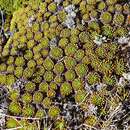en
names in breadcrumbs


Hectorella is a genus of flowering plants belonging to the family Montiaceae.[1] It is monotypic, being represented by the single species Hectorella caespitosa. It is native to New Zealand.[2]
The genus name of Hectorella is in honour of James Hector (1834–1907), a Scottish-New Zealand geologist, naturalist and surgeon.[3] The Latin specific epithet of caespitosa refers to caespitose meaning tufted or turf-like, from caespes or Cf. caespititius.[4] Hectorella caespitosa was first described and published in Handb. N. Zeal. Fl. Vol.1 on page 27 in 1864.[2]
Hectorella is a genus of flowering plants belonging to the family Montiaceae. It is monotypic, being represented by the single species Hectorella caespitosa. It is native to New Zealand.
The genus name of Hectorella is in honour of James Hector (1834–1907), a Scottish-New Zealand geologist, naturalist and surgeon. The Latin specific epithet of caespitosa refers to caespitose meaning tufted or turf-like, from caespes or Cf. caespititius. Hectorella caespitosa was first described and published in Handb. N. Zeal. Fl. Vol.1 on page 27 in 1864.